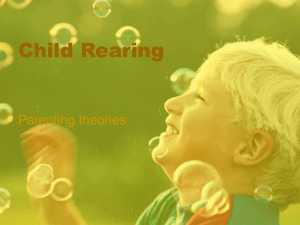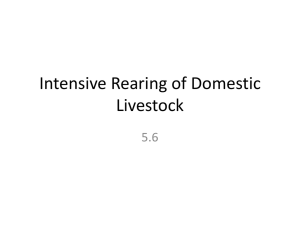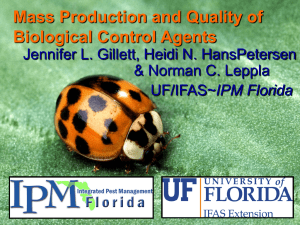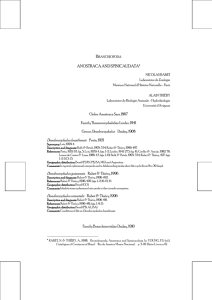Mass production of predatory bugs
advertisement
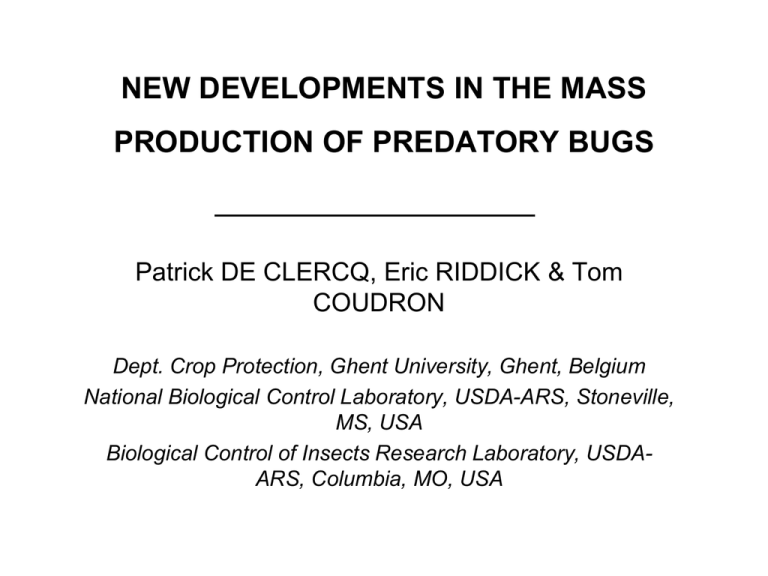
NEW DEVELOPMENTS IN THE MASS PRODUCTION OF PREDATORY BUGS Patrick DE CLERCQ, Eric RIDDICK & Tom COUDRON Dept. Crop Protection, Ghent University, Ghent, Belgium National Biological Control Laboratory, USDA-ARS, Stoneville, MS, USA Biological Control of Insects Research Laboratory, USDAARS, Columbia, MO, USA PREDATORY BUGS IN AUGMENTATIVE BIOLOGICAL CONTROL • Several species of predatory bugs (Heteroptera) are economically important biological control agents • Most are polyphagous, feeding on a wide array of arthropod prey; many species can also exploit plant resources (omnivory) • Important heteropteran predators used in augmentative biological control include: – Anthocoridae: Orius spp. (thrips, aphids…) – Miridae: Macrolophus pygmaeus, Nesidiocoris tenuis (whiteflies, leaf miners, spider mites…) – Geocoridae: Geocoris spp. (whiteflies, thrips, mites…) – Pentatomidae: Podisus, Perillus, Arma spp. (lepidopteran and coleopteran larvae…) – Reduviidae: Rhynocoris, Zelus spp. (lepidopteran larvae…) PREDATORY BUGS IN AUGMENTATIVE BIOLOGICAL CONTROL Nesidiocoris tenuis Arma chinensis Orius laevigatus Macrolophus sp. Geocoris sp. Zelus sp. REARING OF PREDATORY BUGS FOR BIOLOGICAL CONTROL • The main challenge for augmentative biological control is a wide availability of cheap and effective natural enemies for the growers cost-effective and reliable mass production of high-quality natural enemies is essential • The present paper will review developments in the rearing of predatory bugs as related to: – Foods: natural, factitious, artificial – Plant materials and alternatives – Rearing techniques and colony maintenance??? – Quality assurance REARING SYSTEMS FOR PREDATORY BUGS BASED ON FOOD TYPES • Natural rearing systems: use the natural or target prey for production of the predator, usually on a host plant • Systems using factitious prey: organism that is unlikely to be attacked by a natural enemy in its natural habitat, but that supports its development and/or reproduction; usually a species that is easier and less expensive to rear; with or without plant materials • Artificial rearings systems: use inanimate artificial foods and preferably no plant materials NATURAL REARING SYSTEMS • In natural rearing systems the beneficial is reared on its target prey or host, which itself is maintained on its host plant (or on plant parts) "tritrophic" system • These systems can be economically viable: Encarsia formosa, Phytoseiulus persimilis • Possible drawbacks are: • tritrophic rearing systems are expensive due to space and labour needed for plant production • there may be discontinuity problems at one or more of the trophic levels to be maintained (e.g. diseases or other pests attacking host plants) • plant materials should be free of pesticide residues! • there are risks of contamination associated with the release of beneficials reared on natural substrates FACTITIOUS, UNNATURAL OR ALTERNATIVE FOODS • The use of factitious foods may allow some rationalization or automation of production or release • Factitious host or prey: organism that is unlikely to be attacked by a natural enemy in its natural habitat, but that supports its development and/or reproduction • Usually a species that is easier and less expensive to rear • Examples: – Storage mites for predatory mites (Phytoseiidae, Laelapidae) – Eggs of lepidopterans for insect predators – Brine shrimp cysts for predatory insects and mites Eggs of lepidopterans • Eggs of several easily reared lepidopteran species can be used as a factitious food for arthropod predators and Trichogramma egg parasitoids: Ephestia kuehniella, Sitotroga cerealella, Corcyra cephalonica… • Eggs are frozen or (UV, gamma) irradiated for use • Eggs of E. kuehniella are a nutritionally adequate food for > 10 spp. of predators and several Trichogramma spp. 72% water; dry matter: 46% protein, 34% fat (>50% is 18:1), 8.5% carbohydrates • High price of E. kuehniella eggs (ca. 500 EUR/kg) due to investments for climatization and mechanization, and foods • Production poses possible health hazards for workers (allergy to scales) Eggs of the Mediterranean flour moth Ephestia kuehniella are the basis for rearing Orius, Macrolophus, Adalia, Chrysoperla… and Trichogramma egg parasitoids Looking beyond the borders: the Artemia story • Cysts (= diapausing eggs) of brine shrimps, Artemia sp. (Crustacea), are a feed used in aquaculture for shellfish and fish production • The cysts were developed as a factitious food for predatory insects at Ghent University • The cysts can be offered to the predators in encapsulated or decapsulated form (= rigid outer shell removed with hypochlorite), and in hydrated or dry form Non-decapsulated Decapsulated Artemia cysts versus Ephestia eggs Looking beyond the borders: the Artemia story • Artemia cysts proved acceptable for predators with both chewing and piercing-sucking mouthparts • Artemia cysts have now replaced Ephestia eggs in the commercial production process of predatory bugs; they also hold promise for the rearing of predatory mites • Cysts can be offered in part of the life cycle (e.g. nymphal stage) or in a mixture with Ephestia eggs • Cost of cysts is 1/10th or less of that of Ephestia eggs; cysts can be easily stored in dry form ARTIFICIAL DIETS • The availability of an artificial diet may offer further possibilities to automate the rearing process • Types of diets: Diets with and without insect components (e.g., whole insect bodies, hemolymph...) Oligidic, meridic and holidic diets: - Holidic: chemically defined diets (amino acids, fatty acids, sugars, vitamins, minerals...) - Meridic: holidic base with one or more unrefined or chemically unknown substances (e.g., yeast, liver extract...) - Oligidic: containing only crude organic materials (e.g., meat diets) HOLISTIC METHOD FOR DEVELOPING AN ARTIFICIAL DIET ARTIFICIAL DIET Mix of proteins Biochemical analyses of preferred food (amino acids, fatty acids, sugars, …) Digestive enzymes of the predator Biochemical composition of the artificial diet Copy Computing Mix of fats and oils Copy (amino acids, fatty acids, sugars,…) Growth factors (vitamins, minerals, proteins…) Water content Biochemical analyses of natural enemy fed on artificial diet Physical properties (gelling or filling agents, encapsulation…) Preservation The right components, in the right proportions and taking account of possible interactions among the components Orius laevigatus feeding on a meat and liver diet wrapped by hand in Parafilm Egg yolk based artificial diet for Macrolophus pygmaeus in machine-made Parafilm domes PLANTLESS REARING SYSTEMS • Many arthropod natural enemies require plants for successful development and reproduction: – Source of water and supplementary nutrients (omnivory!) – Living substrate and refuge – Oviposition substrate (e.g. Macrolophus, Orius) • If plant materials could be omitted from the rearing systems, there would no longer be a need to maintain large surfaces of greenhouses or to purchase (often pesticide contaminated) plant materials on the market PLANTLESS REARING SYSTEMS • Omission of plant materials from the rearing system of beneficials would require the development of artificial moisture sources, living and oviposition substrates • Such substrates are now being used for mass production of certain predatory bugs Nesidiocoris tenuis Hydrocapsules filled with water as an artificial moisture source Nesidiocoris tenuis QUALITY OF NATURAL ENEMIES REARED UNDER UNNATURAL CONDITIONS • When rearing a natural enemy on a factitious host or artificial diet, loss of fitness may occur because of genetic or non-genetic changes in biological, biochemical, physiological and behavioural traits, which may affect its quality as a biocontrol agent => need for quality assurance! • Nutritional deficiencies may only become clear after several generations, leading to lower viability and/or reproduction (e.g. Orius bugs on Artemia cysts) markers • Genetic adaptation and associative learning may affect host/prey acceptance or parasitization/predation capacity of a parasitoid/predator reared on an unnatural food (e.g. lower acceptance of target host Ostrinia nubilalis in Trichogramma parasitoids after long term rearing on E. kuehniella eggs) Age specific fecundity of Orius laevigatus in the first and third generation on Artemia cysts 12 Number of eggs per female per day Eph G1 Eph G3 10 SFB G1 8 SFB G3 6 4 2 0 0 10 20 30 Time (days) 40 50 60 QUALITY OF NATURAL ENEMIES REARED UNDER UNNATURAL CONDITIONS • Assessing developmental and reproductive fitness of natural enemies is often tedious and time consuming • Rapid tools to assess reproductive potential include: – Correlating easily measured parameters (e.g. size) with fecundity – Dissection tests to count oocytes in ovaria – ELISA-based detection of yolk proteins dorsal plate of phytoseiid mite dissection of Orius PRODUCTION OF NATURAL ENEMIES: RESEARCH CHALLENGES • The development of artificial diets is not about nutrition alone. The complexity of designing these media requires expertise from different disciplines • We need to improve our understanding of the nutritional physiology and ecology of arthropod natural enemies, including interactions with their hosts and micro-organisms • Food processing technology may greatly advance the development of insect diets. Equipment needs to be further developed for large-scale diet preparation and packaging (e.g., extruder applications) • More attention needs to go to the development of effective artificial living and oviposition substrates • Quality control and quality assurance are important considerations for the mass production of natural enemies: “Will they work in the field?”
